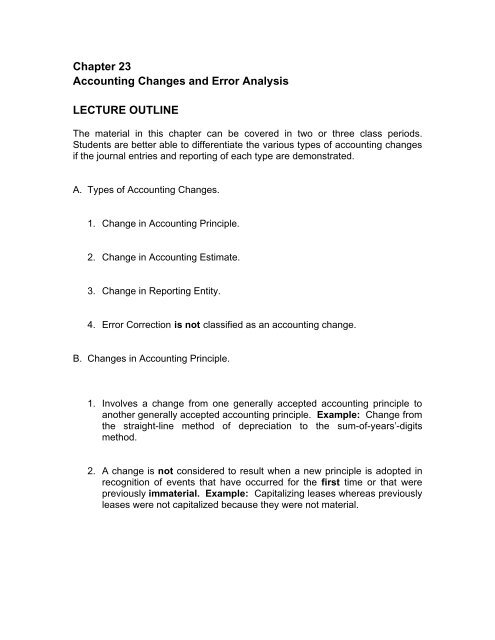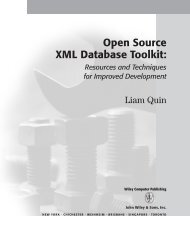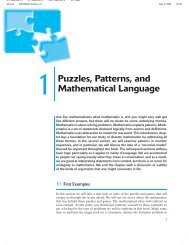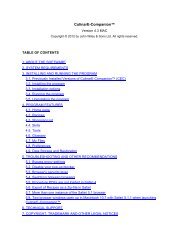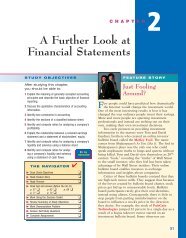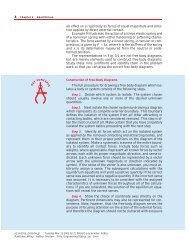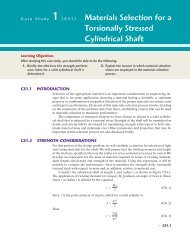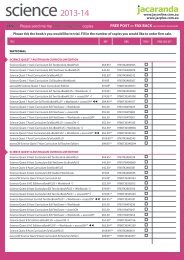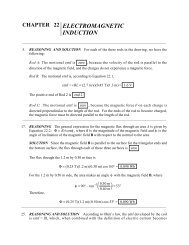Chapter 23 Accounting Changes and Error Analysis LECTURE - Wiley
Chapter 23 Accounting Changes and Error Analysis LECTURE - Wiley
Chapter 23 Accounting Changes and Error Analysis LECTURE - Wiley
Create successful ePaper yourself
Turn your PDF publications into a flip-book with our unique Google optimized e-Paper software.
<strong>Chapter</strong> <strong>23</strong><br />
<strong>Accounting</strong> <strong>Changes</strong> <strong>and</strong> <strong>Error</strong> <strong>Analysis</strong><br />
<strong>LECTURE</strong> OUTLINE<br />
The material in this chapter can be covered in two or three class periods.<br />
Students are better able to differentiate the various types of accounting changes<br />
if the journal entries <strong>and</strong> reporting of each type are demonstrated.<br />
A. Types of <strong>Accounting</strong> <strong>Changes</strong>.<br />
1. Change in <strong>Accounting</strong> Principle.<br />
2. Change in <strong>Accounting</strong> Estimate.<br />
3. Change in Reporting Entity.<br />
4. <strong>Error</strong> Correction is not classified as an accounting change.<br />
B. <strong>Changes</strong> in <strong>Accounting</strong> Principle.<br />
1. Involves a change from one generally accepted accounting principle to<br />
another generally accepted accounting principle. Example: Change from<br />
the straight-line method of depreciation to the sum-of-years’-digits<br />
method.<br />
2. A change is not considered to result when a new principle is adopted in<br />
recognition of events that have occurred for the first time or that were<br />
previously immaterial. Example: Capitalizing leases whereas previously<br />
leases were not capitalized because they were not material.
3. If the accounting principle previously followed was not acceptable, or if<br />
the principle was applied incorrectly, a change to a generally accepted<br />
accounting principle is considered a correction of an error. Example:<br />
Change from capitalizing research <strong>and</strong> development to expensing it.<br />
4. <strong>Changes</strong> in accounting principle are considered appropriate only when<br />
the enterprise demonstrates that the alternative generally accepted<br />
accounting principle is preferable to the existing one.<br />
5. Three approaches for reporting such changes have been considered:<br />
a. Retroactively: A retroactive adjustment of previous years’ financial<br />
statements is made.<br />
b. Currently: The cumulative effect of the new method is computed <strong>and</strong><br />
reported in the current year’s income statement.<br />
c. Prospectively: No change is made in previously reported results.<br />
Effects of change are "spread out" over current <strong>and</strong> future years.<br />
6. Cumulative-Effect Type <strong>Accounting</strong> Change. In general, changes in<br />
accounting principle are treated as follows:<br />
Teaching Tip<br />
Illustration <strong>23</strong>-1 provides a numerical example of a cumulative-effect type accounting change when a<br />
company changes from the sum-of-the-years-digits to the straight-line method of depreciation.<br />
a. The current approach is employed.<br />
b. The cumulative effect of the change is reported in the income<br />
statement in a separate category, net of taxes, between extraordinary<br />
items <strong>and</strong> net income.
c. Prior financial statements are not altered.<br />
d. Income before extraordinary items <strong>and</strong> net income computed on a pro<br />
forma basis are presented as if the new principle had been applied<br />
during all periods affected.<br />
7. Retroactive-Effect Type <strong>Accounting</strong> Change: In five special situations,<br />
the change in principle must be h<strong>and</strong>led retroactively. These situations<br />
are:<br />
a. A change from the LIFO method.<br />
b. A change in accounting for long-term construction-type contracts.<br />
Teaching Tip<br />
Illustration <strong>23</strong>-2 provides a numerical example of a retroactive-effect type accounting change when a<br />
company changes from the completed contract to percentage-of-completion method for long-term<br />
contracts.<br />
c. A change to or from the "full-cost" method of accounting in the<br />
extractive industries.<br />
d. Issuance of financial statements by a company for the first time to<br />
obtain additional equity capital, to effect a business combination, or to<br />
register securities.<br />
e. Requirement by a professional pronouncement.<br />
8. Change to the LIFO method: In such a situation, the base-year<br />
inventory for all subsequent LIFO calculations is the opening inventory in<br />
the year the method is adopted. Disclosure is limited to showing the<br />
effect of the change on the results of operations in the period of change.<br />
This is largely because of the number of assumptions that would be<br />
required to compute the effect of the change.
C. Change in <strong>Accounting</strong> Estimate: Such changes are h<strong>and</strong>led prospectively<br />
since estimates <strong>and</strong> their revision are an inherent part of accounting.<br />
Example: <strong>Changes</strong> in estimates of salvage value or useful life.<br />
1. Whenever it is impossible to determine whether a change in principle or a<br />
change in estimate has occurred, the change should be considered a<br />
change in estimate. Example: Change from capitalizing an asset to<br />
expensing it because the estimate of useful life changes to less than a<br />
year.<br />
2. Careful estimates that later prove incorrect should be considered changes<br />
in estimate <strong>and</strong> not errors.<br />
D. Change in Reporting Entity: Such changes should be reported by restating<br />
the financial statements of all prior periods presented. Example: Presenting<br />
consolidated statements in place of statements of individual companies.<br />
E. Correction of an <strong>Error</strong>: Corrections of errors should be h<strong>and</strong>led as prior<br />
period adjustments. Example: Making mathematical error in the<br />
determination of a prior period’s depreciation expense.<br />
Teaching Tip<br />
Illustration <strong>23</strong>-3 provides a summary of accounting changes <strong>and</strong> correction of errors.<br />
F. Management’s Motivation for <strong>Accounting</strong> <strong>Changes</strong>.<br />
1. Political costs: The larger the company, the more likely it is to adopt<br />
income decreasing approaches in selecting accounting methods.<br />
2. Capital structure: Companies with high debt-to-equity ratios are more<br />
likely to select accounting methods that will increase net income.
3. Bonus payments: Management will select accounting methods that<br />
maximize income, if their bonuses are tied to income.<br />
4. Smooth earnings: In order to avoid attraction; the attention of politicians,<br />
regulators, <strong>and</strong> competitors companies sometimes chose accounting<br />
methods that provide gradual increases in income.<br />
G. <strong>Error</strong> <strong>Analysis</strong>.<br />
1. Balance Sheet <strong>Error</strong>s. Only affect assets, liabilities, <strong>and</strong> stockholders’<br />
equity: Example: A misclassification of an asset.<br />
2. Income Statement <strong>Error</strong>s. Only affect revenues <strong>and</strong> expenses.<br />
Example: a misclassification of a revenue account.<br />
3. Balance Sheet <strong>and</strong> Income Statement Effect.<br />
a. Counterbalancing errors are those that will be offset or corrected<br />
over two periods. Example: <strong>Error</strong>s with respect to inventory.<br />
(1) If the books have been closed:<br />
(a) No entry necessary, if error already counterbalanced.<br />
(b) If error not yet counterbalanced, need entry to adjust retained<br />
earnings.<br />
(2) If the books have not been closed:
(a) If error already counterbalanced <strong>and</strong> company is in second<br />
year, need entry to adjust the beginning retained earnings<br />
balance <strong>and</strong> to correct the current year.<br />
(b) If error not yet counterbalanced, also need entry to correct<br />
beginning retained earnings balance <strong>and</strong> correct the current<br />
period.<br />
(3) If comparative statements presented, restatement of the amounts<br />
is necessary even if a correcting entry is not required.<br />
Teaching Tip<br />
Illustration <strong>23</strong>-4 provides a numerical example of a counterbalancing error when a company fails to<br />
accrue wages at year-end. Illustration <strong>23</strong>-5 can be used to show the difference between<br />
counterbalancing <strong>and</strong> noncounterbalancing errors.<br />
b. Noncounterbalancing errors are those that take longer than two<br />
periods to correct themselves or never correct themselves. Example:<br />
<strong>Error</strong>s with respect to depreciation.<br />
(1) Correcting entries are needed, even if the books have been closed.


